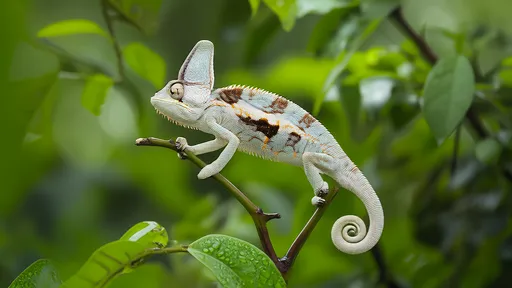In the dense rainforests of Central America, a subtle but significant change is occurring among lizard populations. Researchers have documented a curious phenomenon where certain species of lizards are exhibiting progressively lighter skin pigmentation over successive generations. This shift, far from being a mere curiosity, may serve as one of nature's most sophisticated early warning systems for environmental upheaval.
The lizards in question, particularly the common anole species, have long been studied for their remarkable adaptability. Their ability to change color for camouflage and thermoregulation is well-documented. However, what scientists are observing now appears to be a permanent genetic adaptation rather than a temporary physiological response. Field studies across multiple habitats show that populations living in areas with significant environmental stressors demonstrate markedly lighter coloration compared to their counterparts in more stable ecosystems.
What makes this color change particularly noteworthy is its correlation with specific ecological threats. Areas where lizards show pronounced lightening tend to be regions experiencing rapid deforestation, rising temperatures, or pesticide accumulation. The pigmentation shift isn't uniform across all populations, but follows a distinct pattern that mirrors environmental degradation gradients. Herpetologists have found that the degree of color lightening can predict the severity of habitat alteration with surprising accuracy.
The biological mechanisms behind this transformation are complex. Melanin production, responsible for darker pigmentation, appears to be suppressed under environmental stress. Some researchers theorize this might be an evolutionary trade-off - diverting energy from pigment production to more critical survival functions. Others suggest the lighter coloration provides better camouflage in altered habitats where leaf litter and vegetation patterns have changed due to human activity.
This phenomenon isn't limited to tropical species. Similar observations have been made with lizard populations in temperate zones, particularly in Mediterranean climates. The consistency of this pattern across diverse ecosystems lends credence to the theory that color lightening represents a universal stress response in reptiles. What began as isolated observations by field biologists has coalesced into a compelling body of evidence suggesting we may be witnessing a global biological indicator in the making.
The implications extend far beyond herpetology. Conservation biologists are beginning to view lizard pigmentation as a potential bioindicator for ecosystem health. Unlike chemical tests or equipment-based monitoring, lizard populations provide a living, breathing assessment of environmental conditions. Their color changes reflect cumulative stresses that might otherwise go undetected until more severe ecological damage becomes apparent.
Perhaps most alarmingly, the pace of color change appears to be accelerating. Longitudinal studies comparing museum specimens from the early 20th century with contemporary populations show that what was once a gradual evolutionary process has become dramatically compressed in time. This rapid adaptation suggests environmental pressures are intensifying at rates that force unusually swift biological responses. The lizards' changing hues may be telling us that ecosystems are approaching tipping points faster than we anticipated.
As research continues, scientists are working to quantify the relationship between specific environmental factors and degrees of pigmentation change. Preliminary findings indicate that temperature fluctuations show the strongest correlation, followed by habitat fragmentation and chemical contamination. The precise weighting of these factors remains an active area of investigation, with different research teams developing various predictive models.
The scientific community is now grappling with how best to utilize this natural warning system. Some propose establishing standardized lizard color indexes for different regions, creating an early alert network for environmental monitoring. Others caution that while the correlation is strong, more work is needed to establish causation and understand potential confounding variables. What's undeniable is that these small creatures are providing us with valuable insights into the health of our planet.
For local communities and conservationists, the lizards' changing colors offer a visible, understandable sign of environmental change. Unlike abstract climate data or complex biodiversity metrics, a lizard's skin provides immediate, tangible evidence that something in their environment has shifted. This could prove invaluable for engaging public support for conservation efforts and prompting earlier interventions in threatened ecosystems.
As the research develops, one thing becomes increasingly clear: the humble lizard, often overlooked in favor of more charismatic species, may hold one of the keys to understanding and responding to our planet's ecological crises. Their silent chromatic signals, if properly interpreted, could give us the warning we need to take action before it's too late. In a world searching for reliable environmental indicators, nature may have provided one in the most unexpected of forms.

By /Jul 24, 2025

By /Jul 24, 2025

By /Jul 24, 2025

By /Jul 24, 2025

By /Jul 24, 2025

By /Jul 24, 2025

By /Jul 24, 2025

By /Jul 24, 2025

By /Jul 24, 2025

By /Jul 24, 2025

By /Jul 24, 2025

By /Jul 24, 2025

By /Jul 24, 2025

By /Jul 24, 2025

By /Jul 24, 2025

By /Jul 24, 2025

By /Jul 24, 2025

By /Jul 24, 2025